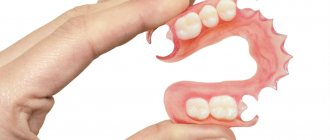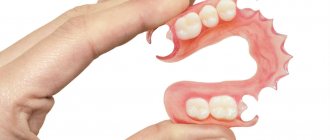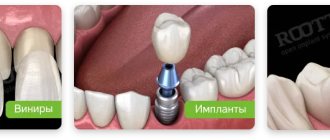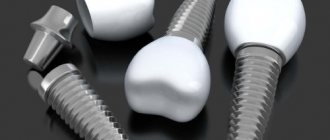From this article you will learn:
- How long can temporary crowns be worn?
- the best plastic option is PMMA,
- how much does a plastic crown cost per tooth – for 2022.
Plastic crowns are a variant of dental crowns that are used for temporary dental prosthetics. The fact is that if you are planning prosthetics with crowns made of ceramics or metal-ceramics, then from the moment of grinding the teeth to fixing the finished crowns, about 10 to 14 more days should pass (this is the time it takes to make them in a dental laboratory). What dictates the need for temporary crowns...
In dentistry, temporary crowns made of plastic are usually used to protect ground teeth from the aggressive environment of the oral cavity, as well as to temporarily restore aesthetics and chewing efficiency. Temporary crowns are also used for implant prosthetics when an immediate or early loading protocol is planned (in this case, a plastic crown or plastic bridge is fixed to the implants either immediately after surgery or during the first 2-4 weeks after surgery).
Plastic crowns: photo
Plastic dental crowns are not used for permanent prosthetics due to their low strength and short service life. For example, the simplest plastic tooth crown, made using the direct method, is designed to last only a few weeks of use. But with more complex laboratory manufacturing, as well as reinforcement of the frame with fiberglass or metal mesh, the service life can sometimes reach 1.5 years. If a plastic crown is made from PMMA (polymethyl methacrylate) using the milling method - about 2 years.
The main advantage of plastic crowns is their ease of manufacture and low price. Because of this, patients often want to get plastic crowns on their front teeth as permanent crowns rather than temporary ones. Below we will talk about the reasons for the negative reviews of such prosthetics (if you regard it as permanent), as well as the significant disadvantages of plastic and metal-plastic crowns that do not allow them to be used for a long time.
Types of plastic crowns –
The traditional option for making such crowns is acrylic plastic. But such plastic can be very different. The most common cheap option is acrylic monomer plastic (most often containing the monomer “methyl methacrylate”). Subsequently, excess monomer can be released from the crown, leading to the development of allergic reactions and inflammation of the gums around the crown. Crowns made from this material have low biocompatibility and wear resistance.
Crowns can also be made of special composite plastic (with the addition of composite) or acetate-free monomer plastic. These plastic options do not contain a toxic monomer, and therefore the risk of allergic reactions in this case is extremely low. But the best manufacturing option is plastic, which is hidden under the abbreviation “PMMA” (polymethyl methacrylate).
What are PMMA plastic crowns:
PMMA crowns are made by milling special plastic blanks (blocks, disks) on a computer-controlled machine. To do this, an impression is taken from the ground teeth, and a plaster model of the teeth made on its basis is digitized. Subsequently, based on the digital impression, the shape of your temporary crowns is modeled on a computer, and their digital profile is sent to a computer-controlled machine, which mills the crowns without human intervention.
Plastic crowns made of PMMA (in Russian transcription - PMMA) not only have maximum accuracy, i.e. they will fit as tightly as possible to the neck of the tooth, but also with the highest degree of biocompatibility. In addition, such crowns may have a higher level of aesthetics, but this will also depend on the PMMA manufacturer. The fact is that PMMA blocks from different manufacturers have different properties, for example, in terms of color - they can be single-layer or multi-layer (Multi-PMMA).
Crowns milled from “multi-layer” PMMA –
“Multi-layer” means that the PMMA resin block will have a gradient of color and transparency, which will allow the crowns themselves made of this material to have the same gradient. This will make even plastic crowns more like real teeth. Reviews of plastic crowns for teeth made of PMMA indicate that their service life can reach about 2 years, which is very long by the standards of temporary prosthetics using plastic. Below you can see how a PMMA disc is milled into a 3-unit bridge.
Milling plastic crowns made of PMMA (video) –
Later in the article we will also show you photos of plastic crowns made from different materials. And you can judge their aesthetics for yourself.
Metal ceramics
More than 30 years ago, the use of metal-ceramics in dentistry became almost a revolution in dental prosthetics. Metal crowns, which did not always look aesthetically pleasing and were noticeable to interlocutors, began to be seen less and less, thanks to the use of new material.
Metal-ceramics is a composite of metal and ceramics.
Various dental metal alloys are used:
- The ratio of noble metals – gold, platinum, palladium;
- The ratio of base metals – cobalt, nickel, chromium;
- Titanium.
Several layers of ceramics are applied manually to the created metal frame. Each stage of application is accompanied by firing in an oven, the temperature inside of which reaches 800-950°C. The final stage of production will be the glazing process to give a glossy appearance to healthy enamel.
The frame is created based on an impression made by the dentist. The resulting frame is tried on by the patient, and only after satisfactory fitting is it sent for ceramic coating. Depending on the complexity and individual characteristics of the patient, making a crown may take several days.
Temporary crowns on teeth (indications for use):
We have already said above that a temporary crown on a tooth made of plastic is most often used to protect ground teeth from aggressive factors in the oral cavity, and also allows you to restore diction and aesthetics - while permanent metal-ceramic or ceramic crowns are being manufactured. This is especially important when it comes to prosthetics of the front teeth. If we are talking about a large number of ground teeth at once, then temporary crowns made of plastic also help restore chewing efficiency - after all, you definitely won’t be able to chew anything with ground teeth.
Some patients refuse to have temporary crowns made, citing large additional costs. But the undoubted fact is that the absence of temporary crowns will negatively affect the ground abutment teeth and the gums around these teeth. The fact is that after preparing a tooth for a crown (grinding off the enamel), the remaining part of the crown of the tooth consists only of a layer of soft dentin, which is completely unstable to bacteria and acids. Therefore, as a result of not wearing temporary crowns, we have a higher risk of developing caries under the crown.
The second very important point concerns the condition of the gums around the tooth. The fact is that after preparing a tooth for a crown, a so-called “ledge” (step) appears in the area of the tooth neck, onto which, in the absence of a temporary crown, the gums will immediately begin to “float”. A slight increase in gum volume, which will occur during 2-3 weeks of waiting for permanent crowns, has extremely negative consequences. This will lead to the fact that after fixing the permanent crowns, the latter will begin to injure the gums around the tooth. As a result, we will get an inflamed bleeding gum margin, as well as unsightly aesthetics of the gums around the tooth under the crown, which is especially important when it comes to the front teeth.
Temporary plastic crowns on implants –
There are a number of methods for dental implantation, when temporary crowns are installed either immediately after the installation of implants (in the first 2-3 hours), or in the first 2-3 days after surgery. Most often, implantation with immediate prosthetics with a temporary crown is used for single missing front teeth - in order to immediately obtain an acceptable level of aesthetics. It should be taken into account that there are several methods for making plastic crowns (including those on implants).
The worst option is when a plastic crown is made from acrylic plastic directly in the mouth (the so-called “direct method”). In this case, the crown will not fit tightly to the neck of the implant, which increases the risk of developing peri-implantitis and impairs the formation of the gum contour around the implant. A little more accurate is the laboratory method, where the crown will be made from an impression in a dental laboratory.
The best option is when a crown made of plastic (namely PMMA, i.e. polymethyl methacrylate) is made by milling on a computer-controlled machine. Such a crown will fit as closely as possible to the implant, plus it does not emit toxic substances, which will reduce the risk of complications and allow you to achieve excellent aesthetics of the gingival margin.
Metal dental crowns
Here it must be said that metal dental crowns can be made using two completely different methods.
A) Stamped dental crowns
They are made from standard materials (stainless steel, in rarer cases gold). In our country they are still used, unfortunately, and are also very fashionable to this day in the countries of Asia closest to us.
If you do not plan to settle in an African-American ghetto or in the Asian countries of the former USSR, then such a smile is unlikely to evoke admiring glances from others...
Throughout the civilized world, our person can easily be identified using such “fixes”. In fact, the place of this technology has long been in the museums of medical universities and students should study it not in the cycle of orthopedic dentistry (as is still the case), but exclusively within the framework of such a useful subject as the “history of medicine”. I will therefore not dwell on these dental crowns in detail. The technology is the simplest (a technician cuts a metal cylinder blank to the required length and, tapping it with a hammer, brings the shape closer to the semblance of a tooth), the cost is a pittance. For the same amount of money you get the same kind of treatment.
Minuses:
- complete absence of any aesthetics (although some residents of the above-mentioned countries could argue with me in this place);
— the edge of the crown hangs between the tooth and the gum, being an excellent tool for accumulating food reserves for a rainy day, causing chronic inflammation of the gums, circular caries, giving the breath a corresponding aroma;
— inability to create a normal anatomical shape; most often, such crowns have an absolutely flat chewing surface, worsening the chewing process and causing problems in the temporomandibular joints;
- the thin walls of such crowns often wear out and rub through, leading to the destruction of the tooth underneath by caries...
I think this is quite enough.
This photo shows stamped dental crowns coated with “gold” titanium nitride. Spraying itself is a carcinogen and is prohibited for use in civilized countries. Here you can clearly see the condition of the crowns themselves and the surrounding tissues after several years of wear. Oddly enough, a crown that has not fallen out for many years does not mean quality treatment. Here you can see what is happening around the crown...
... and here's what's happening underneath. The teeth are completely rotten and cannot be replaced with prosthetics.
An example of a single stamped dental crown without coating...
... and a whole bridge. Such flat chewing surfaces without a pronounced anatomical relief lead to numerous problems that are not always easy to treat. This is especially true for diseases of the temporomandibular joint.
Pros:
— it would be unfair not to mention at least some advantages. If you show the miracles of tolerance, then I can hardly squeeze out two - low cost, minimal processing of tooth tissue. That's it, let's forget about them.
B) Cast metal dental crowns
This is a more modern option, which is widely used in modern dentistry and has a right to life. The technology for making a cast dental crown involves the entire standard sequence (this is discussed in the first part of how dental crowns are installed): processing a tooth with a ledge, taking an impression, casting a model, modeling the crown from wax and melting the wax blank into metal. If all stages are properly completed by the dentist and technician, the result is a crown that fits exactly to the tooth and well reproduces its anatomical shape. It can be made from a conventional alloy (most often KHS - cobalt-chromium alloy) or from a precious alloy, which is certainly better.
Cast metal crowns function at the proper level, are durable and reliable. Therefore, if you are not embarrassed by the prospect of sending sunbeams into the eyes of your interlocutor with your teeth when smiling in clear weather, then you can completely opt for them...
Minuses:
- extremely low aesthetics, although the lateral teeth, which are not so noticeable when smiling and communicating (especially the upper ones), can well be restored with just such crowns
— allergic reactions to metal (especially ordinary alloy) are possible
Pros:
- high wear resistance
- relatively low price
Plastic crowns for front teeth: reviews
A temporary crown for an anterior tooth made from traditional acrylic monomer resin will, in most cases, have very modest aesthetics. Moreover, in order to obtain temporary crowns that are more or less aesthetically acceptable, they will need to be made only in a laboratory manner. But you should immediately take into account that such crowns will not have any gradient of color and transparency (as real teeth have - in the direction from the neck of the tooth to the cutting edge).
Temporary crowns for front teeth: photo
Patient reviews of such plastic crowns on teeth will always be negative. Please note that crowns do not have the gradient of color and translucency that real teeth have. Such crowns are only suitable as temporary structures at most - for the duration of the manufacture of permanent crowns in a dental laboratory, i.e. for about 2 weeks. If you plan to make plastic crowns for a longer period (for example, 2-3 months or even up to 2 years), then they should preferably be made from Multi-PMMA plastic.
Fixation of PMMA crowns on the front teeth (video) –
As you can see, the aesthetics of milled PMMA crowns can be several orders of magnitude better than traditional plastic crowns (made from acrylic resin). We have already said above that in this case, better aesthetics can be achieved by using multilayer PMMA discs (abbreviated “Multi-PMMA”). Look at the photo below: a dental technician holds a multi-layer PMMA disc with single crowns made from it. Note the gradient of color and transparency of both the disc itself and the crowns.
Quality of crowns made from multilayer PMMA discs:
Varieties and stages of production
Today there are two types of such crowns: stamped and cast. The first is a pre-made option, when the prosthesis is made according to a template. Blanks are used on which molten plastic is applied. It is exposed to a special lamp so that the mass hardens. Such prostheses are always available, so the prosthetist can install them quickly enough. True, the structure will have an uneven edge, which means the fit to the gum line will not be tight enough. Because of this, tooth decay can develop over time.
Cast crowns are made according to all the rules: a wax impression is taken, and a metal frame is made from it, onto which plastic is poured. For the base, you can use non-standard material, such as an alloy of cobalt and chromium, or gold. It is more aesthetically pleasing and safer, but takes longer to manufacture, by applying plastic only to the outer part of the base.
Cast crowns are installed like all others. They can also be placed on temporary cement before being permanently fixed.
The stages of manufacturing cast crowns are as follows:
- Using local anesthesia, the doctor prepares one or more teeth.
- The appropriate shade of plastic is determined.
- An impression is made.
- Dentures are made and fixed to the supporting teeth.
According to patient reviews, such crowns do not feel like something alien in the mouth, they are generally quite pleasant and there is no foreign feeling. They can be placed when a person has basically healthy teeth and a strong jaw frame. However, you definitely shouldn’t expect them to last long.
Disadvantages of plastic crowns –
The main reason for the short service life of plastic crowns is their significantly lower strength (compared to any other types of crowns), as well as the high rate of abrasion of the chewing surface. As a result, with prolonged use there is a high risk of fractures and cracks in the frame of plastic crowns. Plastic crowns made of PMMA have higher strength (about 130 MPa, which is comparable to the strength of crowns made of feldspathic ceramics).
The patient can warn the doctor in advance that for some reason he plans to wear temporary crowns for longer than expected (for example, several months or more). In this case, the doctor will probably suggest that you make temporary crowns with reinforced fiberglass or with a frame made of metal mesh, or again, from PMMA. But you need to be prepared that the cost of each such crown will be 2000-3000 rubles more - compared to a regular plastic crown.
How long can you walk with temporary crowns? In general, walking for more than 1 month with temporary plastic crowns (made from ordinary acrylic plastic by direct or laboratory methods) is not recommended. Firstly, they have a rather negative effect on the gums around the crown, promoting the development of inflammation in it. Secondly, they have a fairly low manufacturing accuracy and may not fit tightly around the neck of the tooth, which can lead to saliva and bacteria getting under the crown and rotting of the tooth tissue.
The mechanical strength of a temporary plastic crown will depend on its thickness. For example, for metal-ceramics, the tooth is ground on all sides by an average of 1.5-2.0 mm, and in this case the plastic crown on the tooth is thick and strong enough to last for quite a long time (however, if you plan to wear such crowns for six months and more - in any case, their frame needs to be additionally reinforced). For a ceramic crown, the tooth is ground down only 1.0-1.5 mm, and therefore a temporary crown on a tooth of this thickness will last only a very short time.
Disadvantages of acrylic plastic crowns –
- low strength,
- rapid abrasion of the chewing surface as a result of friction against antagonist teeth,
- plastic is capable of absorbing odors, and therefore after a while begins to emit an unpleasant odor and taste,
- plastic is capable of absorbing dyes, and with prolonged use it acquires a dirty gray color,
- plastic has pores that are gradually colonized by bacteria and subsequently serve as a source of infection,
- chemical components of plastic can cause allergic reactions,
- with prolonged contact with the gums, plastic crowns contribute to the development of inflammation in it,
- temporary crowns, as a rule, have a fairly low accuracy of fit to the neck of the tooth, which, with prolonged use of crowns, can lead to the onset of rotting of the tooth tissue,
- plastic crowns are not suitable for permanent prosthetics also because the supporting teeth under them must be subjected to very strong grinding (in order to make the walls of the crown thicker and stronger).
Important: in some cases, the safety margin of plastic crowns can last quite a long time - from 1 to 2 years (for example, if they were made of PMMA, or the frame was additionally reinforced). But in any case, we still do not recommend using plastic crowns for more than 3 months, because... even the best of them cannot be a replacement for permanent crown options (for example, ceramic or metal-ceramic).
The highest quality plastic crowns, which also fit the necks of the ground teeth as accurately as possible, can only be manufactured using CAD/CAM technology, which involves milling on a computer-controlled machine. In addition, if we are talking about a temporary crown on an implant (especially in the anterior areas of the dentition), it is better to choose only milled plastic crowns with screw fixation.
Plastic crown for a tooth: price
The aesthetics and durability of plastic crowns largely depend on the quality of the plastic used, as well as the manufacturing method.
The simplest fabrication method is the “direct method”, in which the crown is made directly in the patient’s mouth within 1 hour. Crowns made using this method will be the most inexpensive and not very aesthetic (24stoma.ru). Much more accurate is the manufacturing method in a dental laboratory. Such crowns are made within 1 working day and have satisfactory aesthetics. However, their cost will be almost 2 times higher. It is also possible to manufacture a temporary crown on a computer-controlled milling machine (when high precision is needed). This may be necessary, for example, when making a temporary plastic crown intended for screw fixation on an implant.
How much does a temporary crown cost for 2022 –
- plastic crown (direct method) – from 1500 rubles,
- plastic crown (laboratory) – from 2500 rubles,
- plastic crown (milled, with cement fixation) – from 4000 rubles,
- temporary crown on an implant (milled, with screw fixation) – from 5,000 rubles.
- temporary plastic crown of increased strength (reinforced) – from 5,000 rubles.
If you need to calculate the cost of a temporary plastic bridge, you need to multiply it by the number of crowns in it. For example, a plastic bridge prosthesis for the front or chewing teeth of 3 units (made in a laboratory method) will cost from 7,500 rubles.
Making a temporary crown using the direct method: video
Metal-plastic crowns –
In addition to crowns made entirely of plastic, there are also so-called “metal-plastic crowns” (synonym – metal-plastic crowns). Such crowns have a metal frame, which is lined with a plastic overlay on the front side. Such crowns have more or less acceptable aesthetics, and also have a fairly long service life - up to 5 years.
Structurally, metal-plastic crowns for teeth are made like cast crowns (made of cobalt-chromium alloy) - with an additional plastic facet on the front surface. The advantage of such crowns is their more or less acceptable aesthetics, as well as maintainability. For example, if a plastic veneer chips, it can be repaired directly in the mouth, i.e. a metal-plastic crown does not require removal from the tooth for such repairs.
The disadvantages include their cost, which is already very close to the cost of economy-class metal ceramics made from budget materials (about 5,000 rubles in 2022). An absolute disadvantage is that plastic facets can quickly lose their aesthetic properties and negatively affect the condition of the gums around the crown. We hope that our article: Plastic crowns reviews was useful to you!
Sources:
1. Personal experience as a dentist, 2. “Orthopedic dentistry. Textbook" (Trezubov V.N.), 3. National Library of Medicine (USA), 4. https://www.realself.com/, 5. "Crowns and bridges in orthopedic dentistry" (Smith B.).
Indications for installation
Metal-plastic is used for:
- Single defects (if the coronal part is destroyed by 50% or more);
- absence of several adjacent units (as a bridge for 3-5 teeth);
- increased tooth wear;
- implantation using the Immediate Load method (with immediate load).
Another purpose of metal-plastic structures is prosthetics with one-stage implantation protocols
with instant load. The lightweight plastic composite does not put much pressure on the implanted implants when chewing. A durable metal frame allows you to withstand the necessary load, adjusting the crowns to the patient’s bite during the engraftment of titanium roots.
Read more: about immediate load











